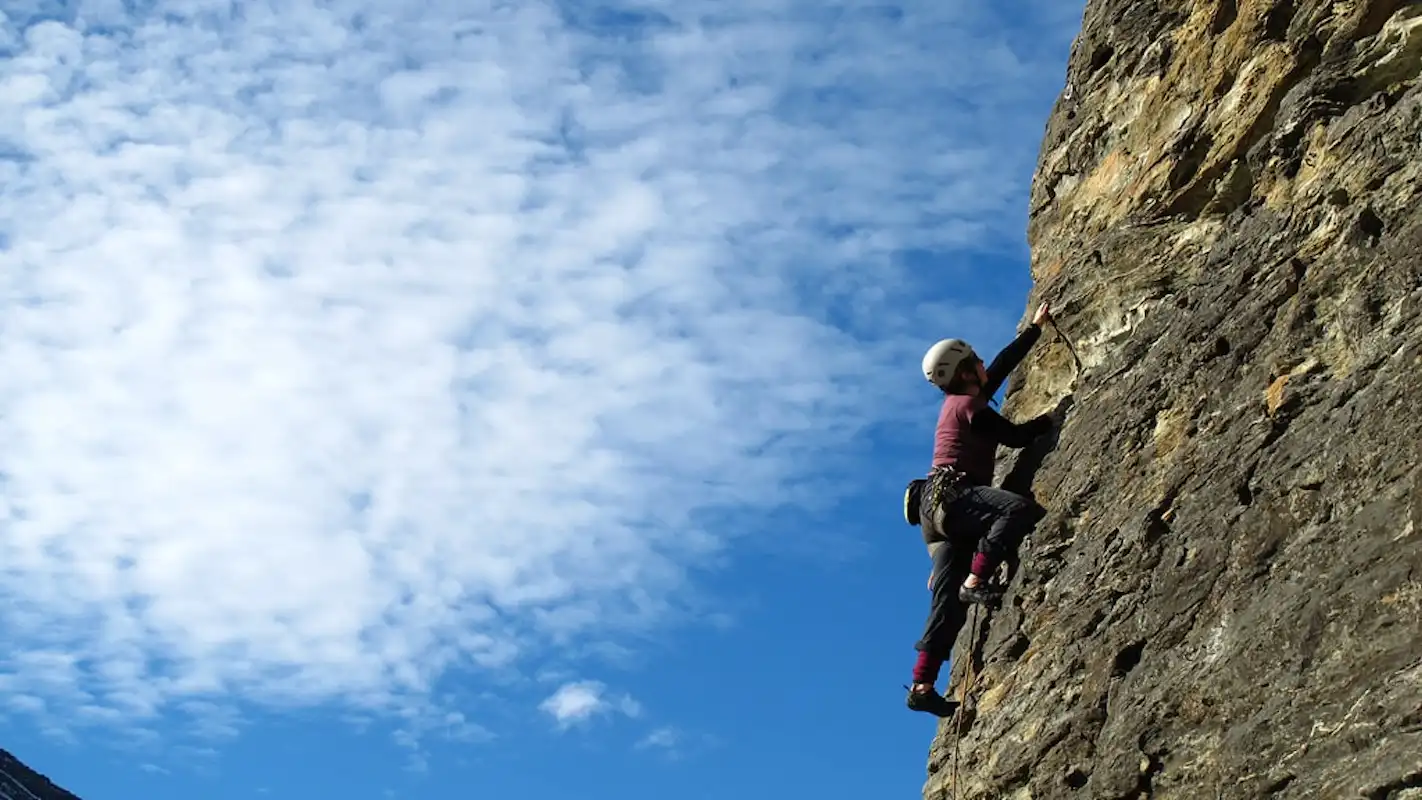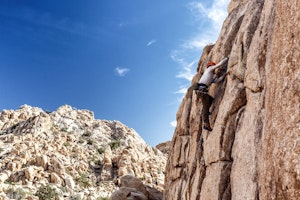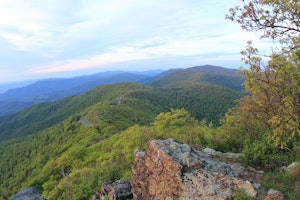Boasting plenty of gorgeous scenery and a richly textured natural landscape, the United States is one of the world’s top rock climbing destinations!
The fourth-largest country on Earth is home to a myriad of different climbing spots. Magnificent monoliths, immaculate walls, and crags, as well as boulders of all shapes and sizes, dot the landscape from the Appalachian Mountains all the way to the Alaska Range.
Within big cities and metropolitan areas, climbing gyms are bringing the sport to urban centers as well. However, the best climbing available is still found in the numerous national parks and natural formations that stretch across the country.
The type of rock varies from region to region, with sandstone, granite, volcanic amalgamations of basalt and tuff, among many others, dominating and defining the country’s landscapes.
This diversity is among the many reasons why mountaineers and rock climbers from across the globe head to the States each year.
Whether you are a trad climber, sport climber, or even a boulder hawk, there are plenty of options for climbers of every ability level and preference to enjoy.
Since you could spend an entire lifetime climbing in the United States and only see a tiny fraction what this incredible country has to offer, we’ve compiled a list of the eight best rock climbing spots in the U.S. to help narrow down your search.
Climbing in the Eastern United States
Generally defined as the slightly smaller half of the country stretching east from the banks of the iconic Mississippi River, the Eastern United States is chock-full of incredible rock climbing opportunities.
Stretching all the way from northern Alabama to the Canadian border, the Appalachian Mountains are the dominant geologic feature of the eastern U.S. Composed mostly of old sedimentary and volcanic rocks, the 480 million-year-old range boasts plenty of incredible rock climbing locales.
Among the most popular spots in the range are the Blue Ridge Mountains, which stretch from Georgia to Virginia, and the Shawangunk Mountains of New York.
The former boasts plenty of great climbing on a range of different types of rocks, including ancient granitic charnockites, unique gneisses and granitoids. The Appalachian subrange is also home to spectacular spots, such as Shenandoah National Park.
Meanwhile, the Shawangunks are one of the oldest climbing spots in the country and remains immensely popular. Along with great views, the subrange boasts pristine quartz conglomerate and great crack climbing.
Away from these two popular spots, the Great Smokey Mountains – sandwiched between Tennessee and North Carolina – and New Hampshire's White Mountains are also quite popular.
The Smokies, as they are known locally, are home to impeccable metamorphic gneiss, granite, and schist rocks as well as the tallest mountains east of the Mississippi. They also offer some great views.
The White Mountains, on the other hand, have some of the highest quality granite in the country, making them extremely popular with trad climbers.
The Shawangunk Mountains, New York
One of the premier climbing areas in the Northeast, the Shawangunk Mountains (informally referred to as the Gunks) are a long-worn set of quartz cracks and slabs in New York state.
The cracks are no joke and the exposure is electrifying, so novices and experts alike should come with their “A” game.
With the beautiful scenery of upstate New York just starting to unfold below, the views are absolutely outstanding. The overhangs and roofs come equipped with relentless forests of lush greenery that make the challenging climbs more than worth their weight in gold.
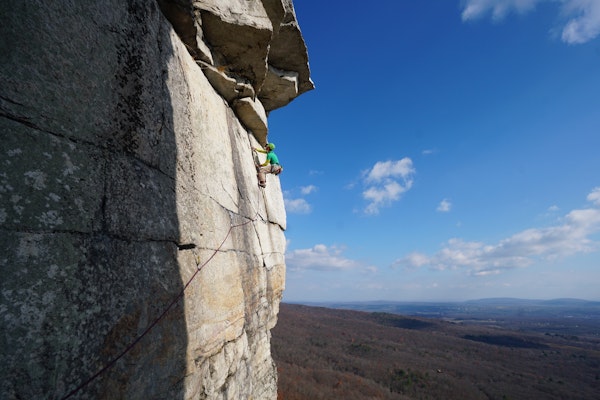
Made up of a variety of cliffs from the Trapps, the Nears, and Millbrook, there are plenty of excellent classic routes, ranging in difficulty from the Son of Easy O (5.8) and Bonnie’s Roof (5.9) all the way up to Supper’s Ready (5.12-).
Sky Top, visible for miles from the surrounding landscape, is a cliff that was recently reopened under the stipulation that you climb with a certified guide from just one authorized guide, Alpine Endeavors.
The Gunks have been a climbing haven since the 1930s, making them one of the first and most classic spots for the sport.
Trad climbers should feel proud to experience the thrills of this nearly 100-year-old destination and carry on a long climbing tradition in the heart New York's Hudson Valley.
In Brief
How to Get to The Gunks: Fly into New York City (Newark, JFK, or La Guardia) before driving north for two hours. The scenic drive along the Hudson River adds to the allure, and for those with the time and forethought can try the Metro-North Railroad for ultimate enchantment.
Climbing Style: Trad (crack)
Difficulty Level: Intermediate to advanced
Type of Rock: Quartz conglomerate
Best Time to Go: Spring to autumn. Adverse winter weather gives way around April and comes in like a lion in late October early November.
Follow one of the AMGA-certified guides of Alpine Endeavors to the Shawangunk Mountains and enjoy a two-day rock climbing course just north of New York City!
Shenandoah National Park, Virginia
Located in the Appalachian Mountains on the western side of Virginia, Shenandoah National Park mixes awe-inspiring beauty with limestone and granite slabs of the highest order.
Rock climbing here is epitomized by the mountain views, complete with crisp blue skies in spring and the sublime changing foliage that comes in the autumn.
The park features a wide array of great climbing areas, including Lil Stony Man, Old Rag, and Bent Tree Area.
You can work on top-roping or practice bouldering, but the claim to fame for Shenandoah is the fulfilling trad lines.
The Crackin (5.11d Grade) nears the higher end of the spectrum, but more basic-level ascents, such as the Shield Direct (5.8) and Kopley’s Corner (5.7) make the area fun for everyone.
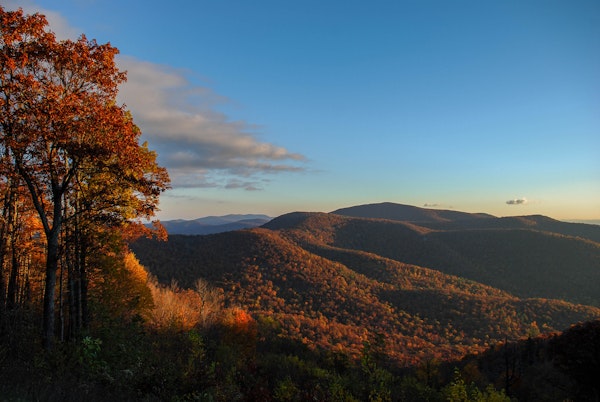
Old Rag Mountain is probably the most infamous climbing area. While it seems to be crowded as you make your way from the trailhead, the technical climbing scene here is relatively open, even with its healthy bounty of top-notch lines.
Beginners can take advantage of 5.2 routes, too, so picking up the sport here is a great way to start your rock climbing career.
Virginia’s unique and historic wilderness has a palpable energy that beckons to alpinists and climbers from all over the country – and beyond. The flexibility and proximity of the routes within the park make multi-day expeditions just as feasible as a road-side day trip.
In Brief
How to Get to Shenandoah: Fly into the District of Columbia and head a bit more than 100 miles west. The drive is about two hours into the national park.
Climbing Style: Crack, trad, (some) sport
Difficulty Level: Beginner to intermediate
Type of Rock: Granite, sedimentary
Best Time to Go: Year-round. Severe weather can occur in summer and winter, so aim for the innocuous spring and autumn months.
Discover the magic of the Blue Ridge Mountains on a rock climbing program with AMGA-certified guide Lester in Shenandoah National Park!
Climbing in the Western United States
Widely considered to stretch from the western shores of the mighty Mississippi River to the shimmering waters of the Pacific Ocean, the Western United States is home to the lion's share of the country's rock climbing locations.
Unlike the Eastern U.S., which is dominated by one main mountain range, the West is home to several.
The most prominent is the Rocky Mountains, which stretches from New Mexico through Canada. Composed mostly of sedimentary rock, the Rockies are world-famous for their plentiful climbing opportunities.
While Boulder is among the most popular spots for all sorts of trad and sport climbing adventures in the range, there are plenty of other great spots throughout Colorado and its neighboring states.
Traveling farther west, the Sierra Nevada of California and the Cascade Range of northern California, Oregon, and Washington are also prime western U.S. rock climbing locales.
The Sierra Nevada are mostly composed of hornfels, slates, marbles, and schists in the south and granite in the north. Yosemite National Park is the most famous climbing spot in the California range.
Meanwhile, the Cascade Range is composed of basalt and other types of volcanic rock. Of the three states through which the mountain range runs, Washington is the most popular with climbers, boasting plenty of different sport, trad and alpine routes to learn and practice on.
Front Range, Colorado
Running from southern Wyoming all the way down to northern New Mexico, the Front Range of Colorado is the gateway to the West!
The easternmost portion of the iconic Rocky Mountains is home to some of the best views available anywhere in the U.S. as well as some of the top trad and sport climbing routes for beginner and intermediate climbers.
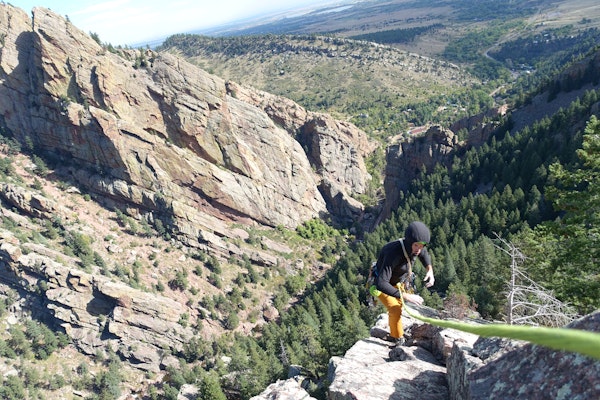
Among the most popular spots in the roughly 275 mile (445 kilometers) long mountain range are just outside of Boulder.
Just west of the city are the iconic Flatirons, which boast some of the best and longest multi-pitch climbing for beginners anywhere in the country. A bit farther south is El Dorado Canyon, which offers some of the highest-quality sandstone climbing found anywhere.
Climbing grades at Eldorado Canyon range from 5.5 all the way to a 5.14 route (Iron Monkey, trad). The Naked Edge (5.11) is one of the most well-known lines and is a great way to get your adrenaline pumping.
Other great routes include Wind Ridge (5.6), Calypso (5.6) and the Yellow Spur (5.9). Advanced climbers will also find some great climbs here, including Scary Canary and Your Mother (both 5.12).
In Brief
How to Get to Colorado: Flying into Denver International Airport is the best way to arrive at the Front Range. From here, the mountains are just a short drive away, ranging from 45 minutes to two hours, depending on where you go.
Climbing Style: Trad, sport
Difficulty Level: Easy to Intermediate
Type of Rock: Granite, limestone, sandstone
Best Time to Go: May through September. Spring and summer are generally warm and sunny in Colorado, making them perfect times to climb. However, afternoon thunderstorms are not rare, making the morning the best time to climb.
Don't hesitate a moment longer! book your next sublime climbing experience to beautiful boulder today!
Moab, Utah
Gorgeous sandstone structures make Moab a hit in the rock climbing community.
Not only is this part of eastern Utah incredibly beautiful, but it also boasts high-quality rock (when dry) that makes for an exciting and unique climbing experience.
Thousands of routes of every stripe cross the region, from the exhilarating towers of Arches National Park (think Owl Rock – 5.8 and Bullwinkle – 5.6, both single pitch, all the way up to Elephant Butte) to the 5.10+ grades of Indian Creek’s crack climbs.
All levels are welcome, and Moab covers all parts of the spectrum when it comes to grades, lengths and disciplines.
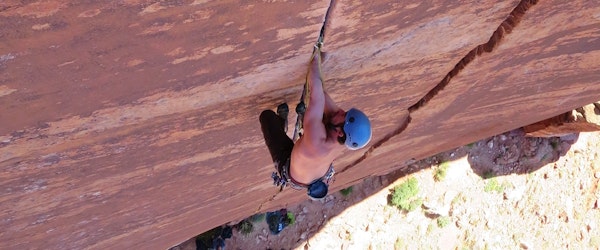
One of the best features of Moab is the wide variety of possible climbs. Routes blend into one another for a never-ending supply of high-quality ascents, so every climb is a new and boundless adventure.
Routes can serve beginners looking to transition from the climbing gym to the outdoors, while also accommodating the seasoned vets, who have traveled far and wide for a taste of the pristine sandstone.
Be careful of the weather, as the wet sandstone can compromise the climbing equipment. A knowledgeable, certified guide will help ensure a safe and satisfactory climb in this idyllic setting of Eastern Utah.
In Brief
How to Get to Moab: Salt Lake City has the closest international airport. Moab can be reached by a four-hour drive.
Climbing Style: Sport, crack (trad)
Difficulty Level: Beginner and up
Type of Rock: Sandstone
Best Time to Go: March, April, October, and November. The temperatures are comfortable and the rain is minimal.
Climb the towers of Moab with AMGA-certified guide Jerome!
Red Rock Canyon, Nevada
Whether you feel lucky or not, you can definitely find an unforgettable rock climbing program at Red Rock Canyon, just a short distance west of Las Vegas, Nevada.
Another sweet sandstone spot, the region is bursting at the seems with an eclectic mix of ascents. When the rest of the country cools during winter, this becomes a go-to destination for climbers in search of a quality fix.
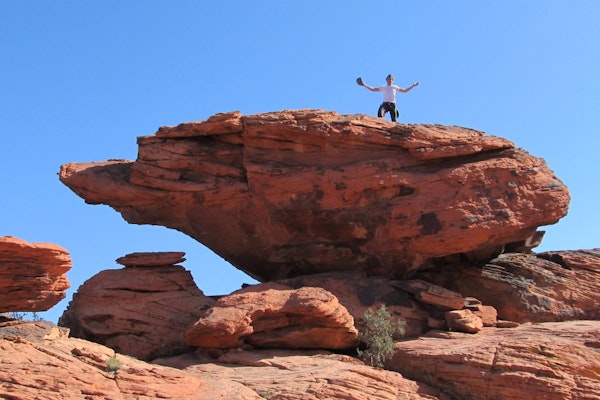
The generous grades are perfect for résumé-building beginners, who flock here for the plethora of variable routes and thousands of options. Grizzled climbers who need to feel alive can test their mettle on Epinephrine (5.9), Cloud Tower (5.12-), and – of course – Monster Skank (5.13).
Every climbing discipline can be found here, even bouldering. You can expect a short single-pitch or a complex 20-pitch tapestry.
Those who wish to train for more exposed and daring routes can get a satisfactory workout on the unique and beautiful geology.
Arguably the best part of Red Rock is its proximity to the city. Few locations in the United States and beyond offer such high-level climbing without a lengthy drive into the wilderness. This uncompromising take on Red Rock has made it a premier spot for mountaineers and climbers.
In Brief
How to Get to Red Rock: With Las Vegas a stone’s throw away, flying into McCarran and driving out can get you onto the rocks within an hour. Maybe less.
Climbing Style: Sport climbing, trad climbing, bouldering. Single- and multi-pitch routes.
Difficulty Level: Beginner and up
Type of Rock: Sandstone
Best Time to Go: Fall to spring. You can go all year round, but the summer heat makes climbing past 11:00 am a chore more than an adventure.
Take Lady Luck to the outskirts of Vegas and spend a day with an AMGA-certified guide on a rock climbing program at Red Rock Canyon!
Joshua Tree National Park, California
No climbing list would be complete without the unique, beautiful, and Southern California vibes of Joshua Tree National Park.
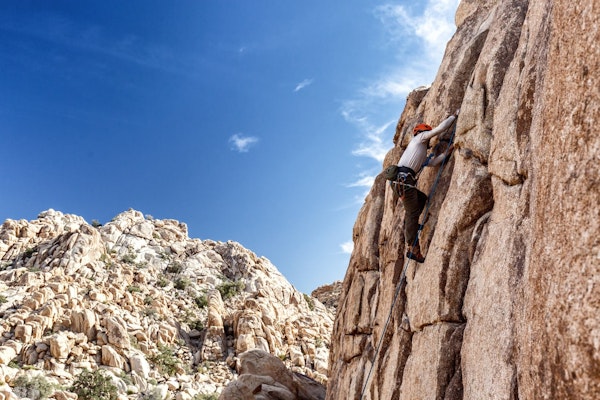
An icon in its own right, climbers have flocked to the national park for years, thanks to impressive outcroppings and an expansive landscape of mountains and desert.
From cracks and slabs to roofs and chimneys, every climber is smitten when placed in the unusual beauty of Joshua Tree.
Boulders help beginners acclimate to single-pitches, which in turn provide an ample training ground for complex multi-pitches, rife with challenges.
Some of the most popular routes are Right On (5.6, four pitches) and Dappled Mare (5.8, four pitches) to Bird On a Wire (5.10a, three pitches) and Leave It to Beaver (5.12a, single-pitch). Boulders blanket the landscape with equally diverse levels of difficulty.
The best way to cap a climbing trip in Joshua Tree is with a symbolic sunset, revealing a desert sky full of stars that will take your breath away.
In Brief
How to Get to Joshua Tree: Fly into LAX (Los Angeles) and enjoy a classic two-hour southwest drive to Joshua Tree.
Climbing Style: Trad, crack, bouldering
Difficulty Level: Beginner and up
Type of Rock: Gneiss, quartz
Best Time to Go: Fall, winter, and spring. Summer can get pretty hot, so be prepared to climb in the morning if you want to brave the heat.
Let the AMGA-certified guides of Mojave Guides take you on a compelling day program full of unforgettable rock climbing in Joshua Tree National Park!
Yosemite, California
Chances are you’ve heard of Yosemite National Park, whether you realize it or not.
As one of the most popular climbing destinations in the country, it has been a source of pride for big wall climbers throughout the history of the sport. Its most notable routes include El Capitan, Half Dome, and Sentinel.
El Capitan is a behemoth, 1,000-meter (3,300 foot) masterpiece that towers over Yosemite Valley. Its most popular route, among many, is the Nose, which features a grueling 5.14 grade and a staggering 31 pitches. Spending two to four days on this amazing ascent is a rite of passage for the most intrepid athletes of the sport.
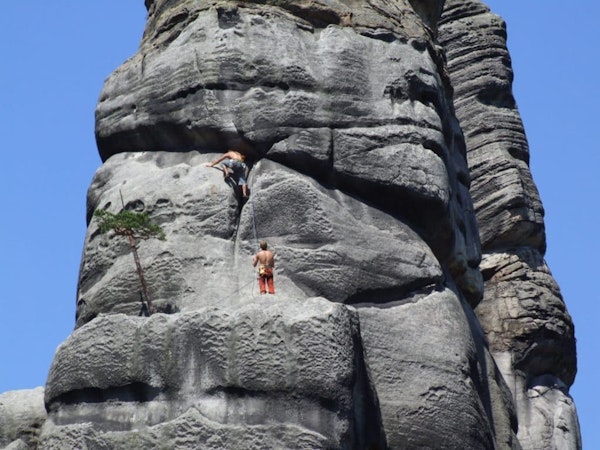
Other popular climbs include Cathedral Rocks and Royal Arches, which are less demanding time-and-length-wise, but just as fun. Graded across the spectrum, these routes run anywhere from 150 to 450 meters (500 to 1,500 feet).
As a bonus, the scenery of Yosemite includes massive sequoias, mountain summits and an abundance of wildlife.
The Sierra Nevada location surrounding the park is home to a variety of outdoor sports. This can motivate travelers to extend or enhance an unforgettable rock climbing program.
In Brief
How to Get to Yosemite: San Francisco is the largest nearby airport. Driving from there, you can be at the foot of El Capitan in under four hours.
Climbing Style: Big wall, trad, (some) sport, bouldering. Single- and multi-pitch courses.
Difficulty Level: Intermediate to Advanced
Type of Rock: Granite
Best Time to Go: Spring and autumn. March through May and September through November. The hot summers and cold winters don’t provide the same appeal as the delightful mild seasons of the Sierra Nevada.
Check out this great two-day trad climbing class from certified guide Daniel!
Smith Rock State Park, Oregon
Oregon tends to fly under the radar, but when it comes to jaw-dropping natural beauty, Smith Rock State Park makes its way to the front of the line.
A vast network of trails in this high-desert location compliments the volcanic geology. Built primarily for sport climbing, it is considered a flagship location for rock climbing and, as a result, holds a strong appeal for international climbers.
There is a bit of everything at Smith Rock, but the park is best known for its tried and true routes that make advanced climbers blush.
It has been developed from the 1960s on, so worn out equipment can add challenges on an ascent.
The views of the Crooked River winding through the park also contribute to its iconic charm. Gorges below and the Cascades on the horizon are enough to make a climber’s heart melt.
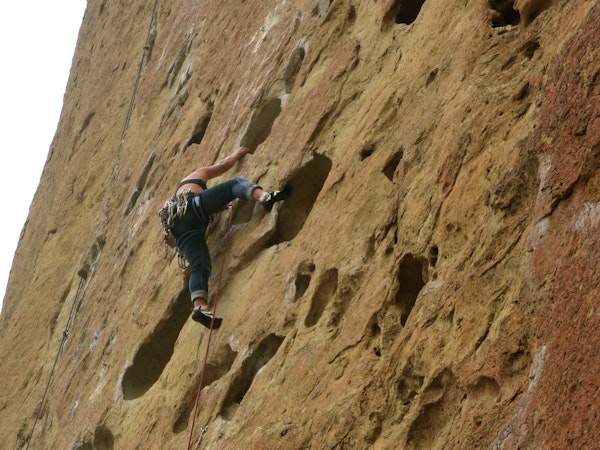
With more than 1,800 routes, varying lines can be constructed to fit the needs of any upper-intermediate or advanced climber.
Screaming Yellow Zonkers and Pure Palm are classic routes that will warm up the veterans before taking on the notoriously difficult ascents like The Morning Glory (5.13 and up).
The area is known for its difficulty, so be prepared for this. The climbing community has long developed the park and may underestimate the grades of some climbs.
In Brief
How to Get to Smith Rock State Park: After flying into Portland, Smith Rock State Park is just a three-hour drive to the southeast.
Climbing Style: Sport
Difficulty Level: Advanced
Type of Rock: Basalt, tuff
Best Time to Go: March through May, September through November. Summer can hit 100 degrees (F) while winter can break below 0 degrees (F), so climb at your own risk during these periods.
Join AMGA-certified guide Mick on a rock climbing weekend program at Smith Rock State Park in Oregon!
NOW is the time to book your rock climbing trip with one of the fantastic certified guides! Prepare yourself to reach new heights on an adventure in the lovely United States countryside!
